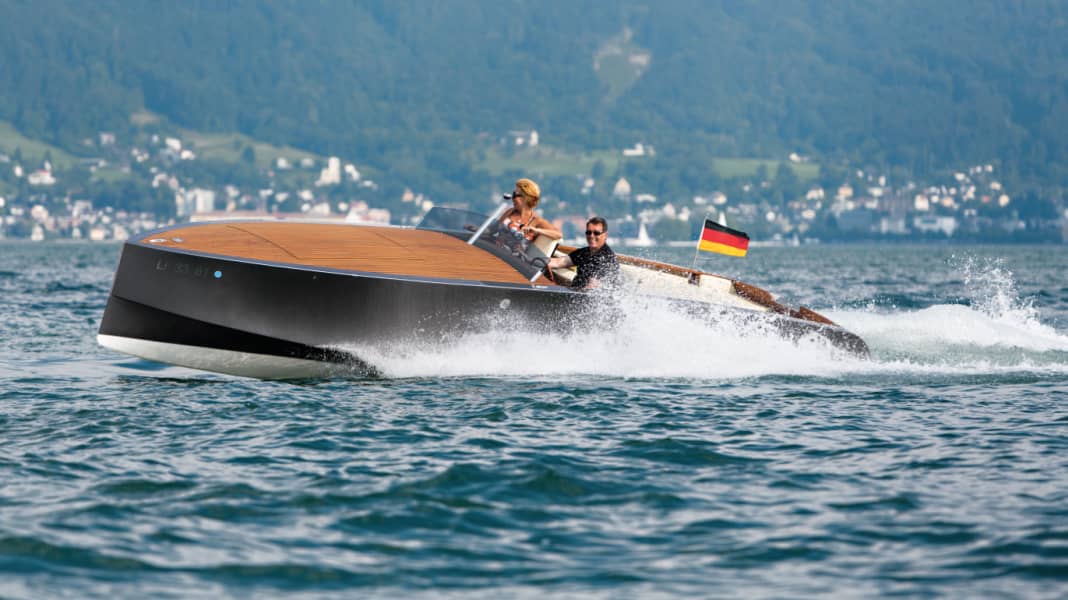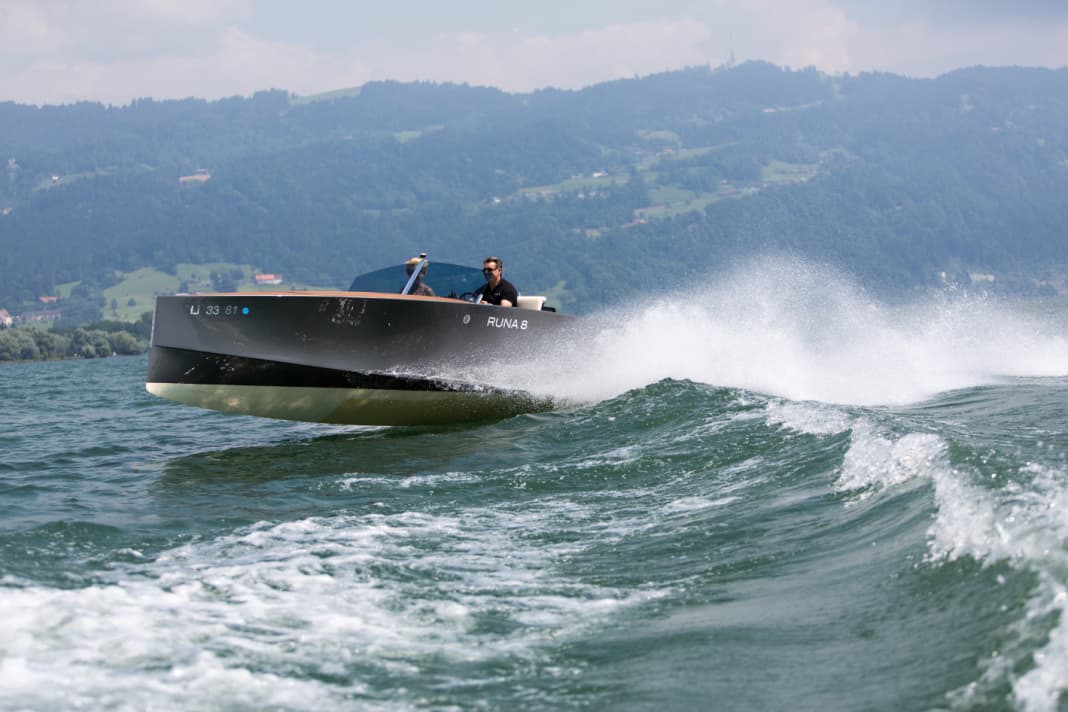Classic from Lake Constance: Runa 8 - Runa 8: German retro runabout at its best
Gernot Apfelstedt
· 01.04.2016

It is 24 May 2009, the last day of theKlassikwelt Bodensee. The Friedrichshafen classic car fair is forAlfred Stenzer from Lindau, around 25 kilometres away, almost a home game. And a must. Because the trained agricultural machinery mechanic and stainless steel designer has a Passion for Vintage car. Both cars and boats - and the combination of both: the legendary car boats and runabouts from the 1920s and 1930s. Unusual for a successful regatta sailor who had never owned a motorboat until three years ago.






But theGentleman RacerandRunabouts with their long wood-planked forecastles make his designer heart beat faster. Especially the famous "Baby Bootlegger", built in 1924 by George Crouch for the Wall Street banker Caleb Bragg, who subsequently used it to win the legendaryGold Cup has done it to him. Also withHacker-Craft, oldest manufacturer ofWooden motorboats in the world, founded by John L. Hacker in the early 1900s, Stenzer goes into raptures.
>>> "Why are there no new boats like this on sale today?" asks Alfred Stenzer
But now - one and a half hours before the final bell - he is standing on theFriedrichshafen Exhibition Centre at the stand of Klink & Krüger, specialists for classic motorboats and automobiles from Berlin-Köpenick (BOOTE 4/2011).Completely mesmerised by an 8.50 m long boat with exceptionally beautiful linesthat was to change his life decisively: the car boat "Germania", built in 1931 by Claus Engelbrecht in Berlin-Köpenick - Klink & Krüger are now restoring it on its former shipyard site.
"Why can't you buy new boats like this today?" asks Alfred Stenzer. Or are they? The stainless steel designer sets off on a search: his preferences are a mid-engine concept, a long foredeck and a large sunbathing area at the back - not on the boat, but in the boat. He looks around, travels, test drives.But what he is looking for apparently does not exist, he realises after five months. At least not to his standards. And they are as high as those of his corporate customers, who approach him with extravagant requests, be it golf course equipment, stainless steel railings, garden design with artistic elements and much more.
So the 54-year-old from Lindau decided to design his own dream boat. Project name: Runa 8.
Aclassic runabout and a maximum length of 8 metres, because it should remain trailerable. Stenzer gives 50 per cent to the foredeck. The engine is to be installed in the centre of the boat to create space for the desired sunbathing area in the "feel-good area" at the rear.Nine months he racks his brains over the iideal lines and all the extras according to the latest state of the art, and constantly produces new CAD drawings. In June 2010, he has all the design templates together and commissions Alexander Mrugowski, a naval architect from neighbouring Wasserburg, to make the necessary calculations.
As he does not want to leave anything to chance in this ambitious project, he calls in three more engineers: Niels Hansen from Navcon in Wollgast, Eckhard Praefke from Ingenieurbüro für Schiffshydrodynamik & Antriebstechnik in Hamburg and Jonas Panacek from Yacht Design & Engineering GmbH in Thalwil/Switzerland. A high financial outlay for Alfred Stenzer, but theEngineering quartet does a good job.
Construction can therefore begin in January 2011. The prospective dream boat owner rents the Prechtl Yachtmarina shipyard in Wasserburg for this purpose,founds a "Runa 8" division in his company Edelstahl + Designand hires Florian Obermeier, an experienced boat builder, to realise the plans of the engineers in a good team and with a lot of Stenzer's own input.
WithM. andH. von der Linden A set of moulds is ordered and used to build a master model. The mould is removed from this, split in the middle, screwed together again to build the GRP hull in sandwich construction and then separated again before the so-called demoulding. Stenzer obtains the engine for the prototype, a 190 hp FNM diesel, directly from the factory in Atella in southern Italy, almost 1200 kilometres away.
The28 February 2012 will be a milestone in the history of this modern runabout with its distinctive negative stern like the paddle steamer "Hohentwiel" (see pages 22-29).first test drive to Lindau - or rather her naked, freshly demoulded hull as the traces of wax on the bow reveal.
The lake is as smooth as glass, with outside temperatures ofminus 3 degrees no other boat on the way. But Alfred Stenzer and Florian Obermeier, who have taken a seat on makeshift plywood seats, no longer feel the cold from all the excitement and joy."I was on 1000 inside, the adrenalin was almost coming out of my ears"Stenzer recalls.
An uplifting feeling for the stainless steel designer from Lindau after so much meticulous preparatory work. The maiden voyage is a resounding success, documented by team photographer Bernhard Schmitt from a Belgeit boat with 260 pictures.
Back on land, the prototype of the Runa becomes a real success within the next six months.A marvel of modern technology with every conceivable practical extra and design highlight. Stenzer attaches great importance to comfort in the rear of the boat. Theentire electrical system The Runa 8 is based on a programmable logic controller (PLC).
AKeystroke on the remote control and the completeOn-board power supply switches on. A second press and theTailgate opens, through which you enter the boat and reach the driver's and co-driver's seats via a 40 cm wide passageway between the loungers. There, numerous function switches make it easy to control everything else: B, for example, stands forBow flaps Thanks to the PLC, one flap opens and closes before the other depending on the position of the water fold. TheWindscreen (W) can be lowered by 30 cm to enjoy "the full driving experience" at will.
TheLoungers (L) can be moved together and apart again, but each still has its own separate switch. Finally, H opens and closes theTailgate (bathing platform). Navigation lighting - which can be lowered in the same way as cleats and mooring lines -, the eight bow lights and interior and exterior lighting (switches N, B, I, A) can also be switched on or off centrally. ThePush-button start automatically. So there's no need to "organise" until the engine starts. If you go refuelling, you don't need to worry about the position of the filler necks. The Runa has both starboard and port filler necks, and the 100-litre fuel tanks are connected to each other.
The fact that the Runa 8 - just in time for theInterboot 2012 finished -attracted attention in the harbour like the "Germania" car boat three years earlier at Klassikwelt Bodensee, is the reward for an extraordinary design that prioritises aesthetics without neglecting functionality.
Shortly before the Interboot 2015 (19-27 September)the second Runa 8 has been completedV8-1. Your 150 kg lighterCarbon hullcompensates for the higher weight of the more powerful petrol engine and the double exhaust system. Unlike the first Runa, which will once again be moored in the Interboot harbour, the new one can be admired in Hall A6 and stands for285,000 euros for sale.
Info: Runa Bootsmanufaktur, Heuriedweg 42, 88131 Lindau, Tel. 08382-97 61 20, www.runa8.de
Downloads:
download

